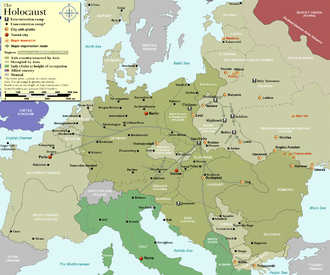
Back قطارات الهولوكوست Arabic Τρένα του Ολοκαυτώματος Greek Trenes del Holocausto Spanish قطارهای هولوکاست Persian Trains de la Shoah French טרנספורט HE Kereta api Holokaus ID Treni della morte Italian Ferrovias do Holocausto Portuguese Trenurile morții Romanian
| The Holocaust trains | |
|---|---|
 Polish Jews being loaded onto trains at Umschlagplatz of the Warsaw Ghetto, 1942. The site is preserved today as a Polish national monument. | |
| Operation | |
| Period | 1941–1944 |
| Location | Nazi Germany, German-occupied Europe, Axis countries in Europe |
| Prisoner victims | |
| Destination | Transit ghettos, Nazi concentration camps, forced labour and extermination camps |

Holocaust trains were railway transports run by the Deutsche Reichsbahn and other European railways under the control of Nazi Germany and its allies, for the purpose of forcible deportation of the Jews, as well as other victims of the Holocaust, to the Nazi concentration, forced labour, and extermination camps.[1][2]
The speed at which people targeted in the "Final Solution" could be exterminated was dependent on two factors: the capacity of the death camps to gas the victims and quickly dispose of their bodies, as well as the capacity of the railways to transport the victims from Nazi ghettos to extermination camps. The most modern accurate numbers on the scale of the "Final Solution" still rely partly on shipping records of the German railways.[3][4]
- ^ Prof. Ronald J. Berger, University of Wisconsin–Whitewater (2002). Fathoming the Holocaust: A Social Problems Approach. Transaction Publishers. pp. 57–58. ISBN 978-0202366111.
Bureaucrats in the Reichsbahn performed important functions that facilitated the movement of trains. They constructed and published timetables, collected fares, and allocated cars and locomotives. In sending Jews to their death, they did not deviate much from the routine procedures they used to process ordinary train traffic.
- ^ Simone Gigliotti (2009). The Train Journey: Transit, Captivity, and Witnessing in the Holocaust. Berghahn Books. pp. 36, 55. ISBN 978-1845459277.
- ^ HOLOCAUST FAQ: Operation Reinhard: A Layman's Guide (2/2).
- ^ Tomasz Wiścicki (16 April 2013), Train station to hell. Treblinka death camp retold by Franciszek Ząbecki [Stacja tuż obok piekła. Treblinka w relacji Franciszka Ząbeckiego], Muzeum Historii Polski [Museum of Polish History], archived from the original on October 6, 2013, retrieved 2 February 2016 – via Internet Archive,
Wspomnienia dawne i nowe by Franciszek Ząbecki (en), Pax publishing, Warsaw 1977.
; also in Clancy Young (2013), Treblinka Death Camp Day-by-Day. Tables with record of daily deportations, Holocaust Education & Archive Research Team, archived from the original on May 22, 2013, retrieved 2 February 2016 – via Internet Archive,Timeline of Treblinka (en).